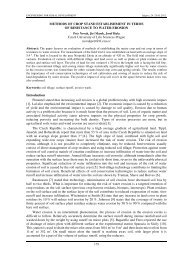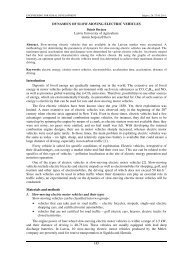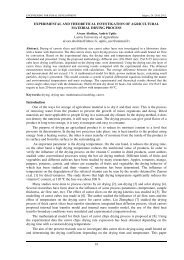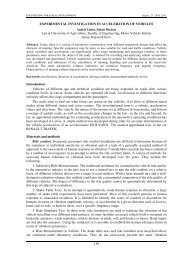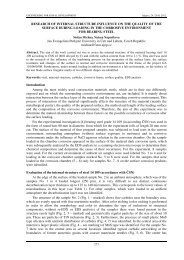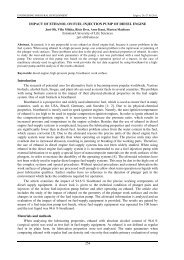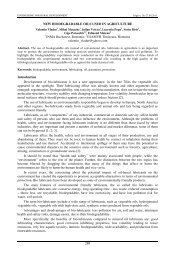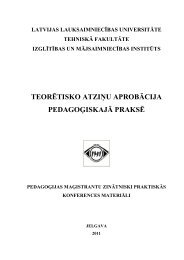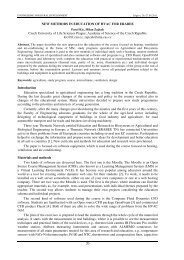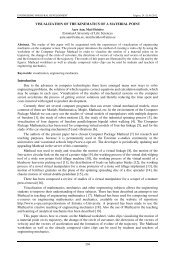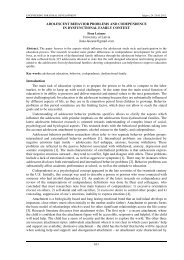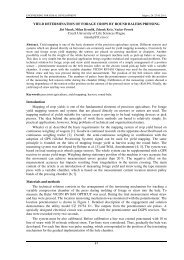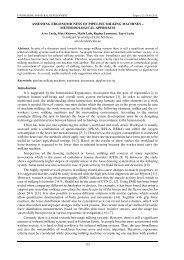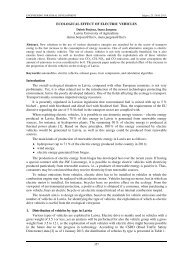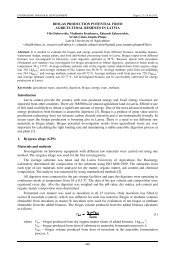Igors Tipans, Semjons Cifanskis, Janis Viba, Vladimirs Jakushevich ...
Igors Tipans, Semjons Cifanskis, Janis Viba, Vladimirs Jakushevich ...
Igors Tipans, Semjons Cifanskis, Janis Viba, Vladimirs Jakushevich ...
You also want an ePaper? Increase the reach of your titles
YUMPU automatically turns print PDFs into web optimized ePapers that Google loves.
ENGINEERING FOR RURAL DEVELOPMENT Jelgava, 26.-27.05.2011.<br />
c – stiffness of spring;<br />
b – damping coefficient;<br />
V 0 – constant velocity of water;<br />
S(t) – area variation;<br />
u(t) – control action (2);<br />
k – constant.<br />
It is required to determine the control action u = u(t) for displacement of a system (2) from the<br />
initial position x(t 0 ) to the end position x(t 1 ) in minimal time (criterion K) K=T, if the area S(t) has limit<br />
(1).<br />
Solution of optimal control problem for system with one degree of freedom<br />
For system excitation any time the high-speed problem must be solved [1-3]:<br />
t<br />
K ∫1<br />
⋅ dt<br />
(3)<br />
=<br />
1<br />
To assume t = ; t = , from (3) we have K = T .<br />
0<br />
0<br />
1<br />
T<br />
t<br />
The problems have been solved using the maximum principle of Pontryagin. It is find out that<br />
optimal control action corresponds to the case of bound values of area limits S 1 , S 2 [4-9].<br />
0<br />
Real control action synthesis<br />
For realizing optimal control actions (in general case) the system of one degree of freedom needs<br />
a feedback system with two adapters: one for displacement measurement and another - for velocity<br />
measurement. There is a simple case of control existing with only one adapter when motion changes<br />
directions [2-4]. It means that the control action is similar to negative dry friction and switch points are<br />
along zero velocity line. In that case equation of motion for large velocity V 0 ≥ x&<br />
is (4):<br />
where<br />
m ⋅ & x<br />
= −c<br />
⋅ x − b ⋅ x&<br />
+ U(x), &<br />
(4)<br />
⎡ 2 1+<br />
sign(<br />
x&<br />
) ⎤ ⎡<br />
2<br />
U ( x&<br />
) = −<br />
⎢<br />
k ⋅(<br />
V0<br />
+ x&<br />
) ⋅ S1<br />
⋅<br />
⎥<br />
−<br />
⎢<br />
k ⋅ ( V0<br />
+ x&<br />
) ⋅ S2<br />
⎣<br />
2 ⎦ ⎣<br />
m – mass;<br />
c, b, F, k, V 0 – constants.<br />
Examples of modelling are shown in Fig. 3-4.<br />
1−<br />
sign(<br />
x&<br />
) ⎤<br />
⋅<br />
2 ⎥<br />
⎦<br />
Pa<br />
-0.6<br />
-0.8<br />
-1<br />
0 1 2<br />
t n<br />
3<br />
2<br />
1<br />
0<br />
-1<br />
-2<br />
v n<br />
⎛ x<br />
0 ⎞ ⎛2.3⎞<br />
⎜<br />
⎟ : = ⎜ ⎟<br />
⎝ v0<br />
⎠ ⎝ 0 ⎠<br />
-3 -2.45 -2.4 -2.35 -2.3 -2.25<br />
x n<br />
Fig. 3. Full control action Pa n =U( x) ̇ in time t n<br />
domain (SI system)<br />
Fig. 4. Motion in phase plane (x=x n ; x=v ̇ n ) with<br />
initial conditions inside of limit cycle<br />
Optimization and synthesis of robot fish tail rotation motion<br />
The second object of the theoretical study is a fin type propulsive device of robotic fish moving<br />
inside water. The aim of the study is to find out an optimal control law for variation of additional area<br />
459



